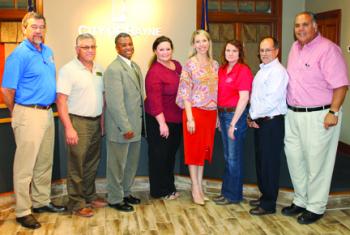
AT RAYNE PRESENTATION: The U.S. Department of Agriculture, Rural Development, presented information on various funding programs available to individuals, businesses and governmental entities during a meeting Wednesday afternoon at Rayne City Hall. Among those in attendance were, from left, Crowley Mayor Greg Jones, Ricky Hulin, construction analyst, USDA/RD; Charles Miniex, area director, USDA/RD; Callie F. Francois, community programs specialist, USDA/RD; Laurie Suire, president and CEO of OneAcadia, sponsors of the event; Morse Mayor Darlene Thibodeaux, Church Point Mayor Russell Stelly and Rayne Mayor Charles “Chuck” Robichaux. (Acadian-Tribune photo by Steve Bandy)
USDA Rural Development funding programs explained
Steve Bandy
LSN News
There are more projects out there funded by the U.S. Department of Agriculture, Rural Development, than most people think.
“We’re here, we’re just not screaming very loud,” Ricky Hulin, construction analyst, USDA, told a gathering of various municipal officials here Wednesday (April 27).
Hulin, along with Callie F. Francois, community programs specialist, and Charles Miniex, area director, were at Rayne City Hall to present a program on USDA Rural Development water and community facilities programs. The event was hosted by OneAcadia.
“We were happy to be able to offer this presentation by USDA and hear of the recent updates to their water and waste programs and community facilities programs in Acadia Parish,” Suire said.
“As part of our mission for progress, OneAcadia strives to connect businesses and individuals with resources that support their visions for growth.”
Miniex explained that the Lafayette Area Office handles 14 parishes and, through the various programs, some form of funding is available for “pretty much anything you can imagine, with the exception of gaming and recreation.”
For example, he continued, the Rural Housing Guaranteed Loan Program assists qualified moderate-income rural home-buyers achieve the dream of home-ownership by “guaranteeing” — providing the collateral — for a mortgage lender.
“Funds can be used to build, purchase existing dwellings, repair or purchase and prepare sites, including providing water and sewage facilities,” he said.
Loans may include closing costs, lender fees, guarantee fees, legal fees, title service, cost of establishing an escrow account and other prepaid items.
There is no maximum loan amount, however, applicants must have “reasonable credit history,” he added.
The Rural Housing Direct Loan Program is used primarily to help low-income individuals or households purchase homes in rural areas. Funds can be used to build, repair, renovate or relocate a modest home, or to purchase and prepare sites.
Applicants must have “low” or “very low” incomes, Miniex said, defining “low income” as between 50 and 80 percent of the area median income and “very low” as below 50 percent of the AMI.
Families must be without adequate housing, but able to afford the mortgage payments, including taxes and insurance.
Applicants must be unable to obtain credit elsewhere, but have “reasonable credit histories,” he said.
Loans are for up to 33 years.
Miniex also touched on a grant program offered by Rural Development for qualified individuals. These one-time grants, he said, are primarily for renovations and can be for as much as $7,500.
He qualified the program, however, by explaining that Rural Development will not simply hand out money for projects that are considered beyond repair.
“We don’t want to give false hope that we can do magic,” he said. “Sometimes there’s just nothing we can do to help.”
Francois explained that interest rates for community facilities loans are now the lowest they’ve been since the 1970s.
She said funding from this program can be utilized for such projects as a community center — provided recreation is not the main purpose of that facility — fire stations and firetrucks, police cars and equipment, sidewalks, jails, etc.
Local examples of a projects using Rural Development loan funding are the Rayne Chamber of Commerce offices, Raintree Apartments and Rayne Manor, Hulin added.
However, community facilities “don’t get a big pot of many for grants,” Francois explained, noting that more grant funding is available for water and waste water projects.
“These are not 100 percent grants,” Francois said. “We look at the finances of the applicant and what can be put into the project.”
She added that “partnering” with other agencies or non-profits is not unusual.
Though the programs are aimed at police juries, school board, mayors and town officials who oversee water and community facility departments, law enforcement and non-profit water systems, a number of individual opportunities concerning housing were explained by Miniex.
Additional resources and program information can be found at www.rd.usda.gov.
- Log in to post comments
